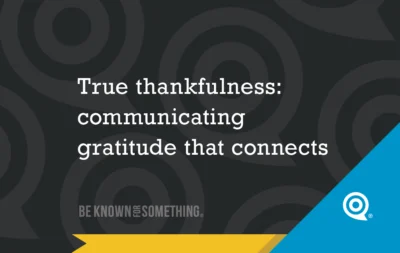Calm Down (Communication Design, That Is)

Marketing communication is tough. There’s so much to say and people are only half listening or reading.
After 3 decades of professionally designing and communicating, I’ve identified the main problem. Our communication is often delivered in a busy, non-organized, and complicated design.
So, calm down. Please. Or risk never being heard, read, or understood.
Here are 5 ways to get started:
- Flatten and simplify. When it comes to design today, people don’t want to see layered and complex design. They want flatness. Simply, stop relying on glows or strokes around things to ensure they’re readable. Stop overlapping elements with lots of transparency. Simplify your design and make it quickly readable. The curse of bad communication design is that art trumps comprehension.
- Eliminate too many choices. When someone receives a multi-page menu from a restaurant, it can be debilitating. It’s difficult to make a choice and ultimately takes a long time! Compared to the restaurants where the chef decides there’ll only be a selection of 5 entrees today. So much easier! Be the chef. Choose what’s best for people to see and direct them quickly to important things and eliminate the unimportant. You should know your church better than them so let them rely on you for the choices. Slowing people down only creates an uneasy feeling and drives people from your communication.
- Restrict fonts and colors. Your brand should have certain restrictions in order to be known for what you look like. People get used to what that is. Don’t confuse them with fonts and colors that are outside of your brand foundation. 1 or 2 fonts are acceptable. Colors should be limited too!
- Line things up in your design. When producing a layout, you’ll have several elements (photos, text, buttons, call-to-action, etc). Most read from left to right in a sweeping manner from the top to bottom. Centering elements require people to find the starting point of the next line in a jagged manner. If things are even more randomly placed; people will find it complex to find the priority of elements and lose the overall communication. Instead, line elements up to an invisible grid with a generous margin around everything. Do you need a single column or do you need more? Then have everything line up that you can. Horizontally and vertically.
- Edit. Edit. Edit. Stop telling everyone everything. Instead, eliminate all non-essentials. If they may need more, tell them they can discover details on your website (as long as they can EASILY find things there). Or maybe, if it’s digital, a button or link will direct them to the next step. Simple communication that gains attention and calls them to a next step is so much better than a complex promotion that is often ignored because it’ll take too much time to wade through it.
Want 25 Game-Changing Resolutions?
Related Posts

True thankfulness: communicating gratitude that connects
We’re just a couple weeks away from Thanksgiving. Though you might not know it by the jingling commercials already flooding

AI Prompts Every Church Communicator Should Be Using
Artificial Intelligence (AI) isn’t replacing church communicators, it’s simply helping the good ones work smarter. Tools like ChatGPT (and similar)

Church Growth Strategy: Clarity That Connects
Most churches pray for growth but overlook one of their most effective tools: a clear church growth strategy built on

